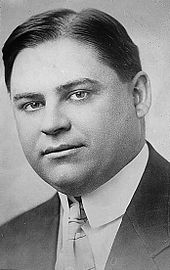2002年美聯的波士頓紅襪隊聘請28歲的基奧・艾普斯坦/Theo Epstein當總經理(GM),這是美國職棒史上破天荒之舉,不出兩年,紅襪隊打破存在86年(1918〜2004)的「貝比魯斯魔咒*」拿下世界大賽總冠軍,後來他短暫離開球團,2006年以三年1,500萬美元的合約又回鍋擔任總經理兼執行副總裁,隔年紅襪再次拿下總冠軍。
*The Curse of Bambino:Babe Ruth/貝比魯斯的父母為義大利移民,義大利語的babe/嬰兒叫bambino。
From Wikipedia, the free encyclopedia
The Curse of the Bambino was a superstition evolving from the failure of the Boston Red Sox baseball team to win the World Series in the 86-year period from 1918 to 2004. While some fans took the curse seriously, most used the expression in a tongue-in-cheek manner.[1]This misfortune began after the Red Sox sold star player Babe Ruth, sometimes called The Bambino, to the New York Yankees in the off-season of 1919–1920.[2] Before that point, the Red Sox had been one of the most successful professional baseball franchises, winning the first World Series and amassing five World Series titles.[3] After the sale they went without a title for decades, even while the Red Sox won four American League championships from 1914 to 1918, as the previously lackluster Yankees became one of the most successful franchises in North American professional sports.[4] The curse became a focal point of the Yankees–Red Sox rivalry over the years.
Talk of the curse as an ongoing phenomenon ended in 2004, when the Red Sox came back from a 0–3 best-of-seven deficit to beat the Yankees in the 2004 American League Championship Series (ALCS) and then went on to sweep the St. Louis Cardinals to win the 2004 World Series.[5] The curse had been such a part of Boston culture that when a "reverse curve" road sign on Longfellow Bridge over the city's busy Storrow Drive was graffitied to read "Reverse The Curse",[6] officials left it in place until after the Red Sox won the 2004 Series. After the Red Sox won the last game of the World Series that year, the road sign was edited to read "Curse Reversed" in celebrat
The lore[edit]
Although it had long been noted that the selling of Ruth had been the beginning of a decline in the Red Sox' fortunes, the term "curse of the Bambino" was not in common use until the publication of the book The Curse of the Bambino by Dan Shaughnessy in 1990. It became a key part of the Red Sox lore in the media thereafter, and Shaughnessy's book became required reading in some high school English classes in New England.[7][8]
Lore definition, the body of knowledge, especially of a traditional, anecdotal, or popular nature, on a particular subject: the lore of herbs


沒有留言:
張貼留言